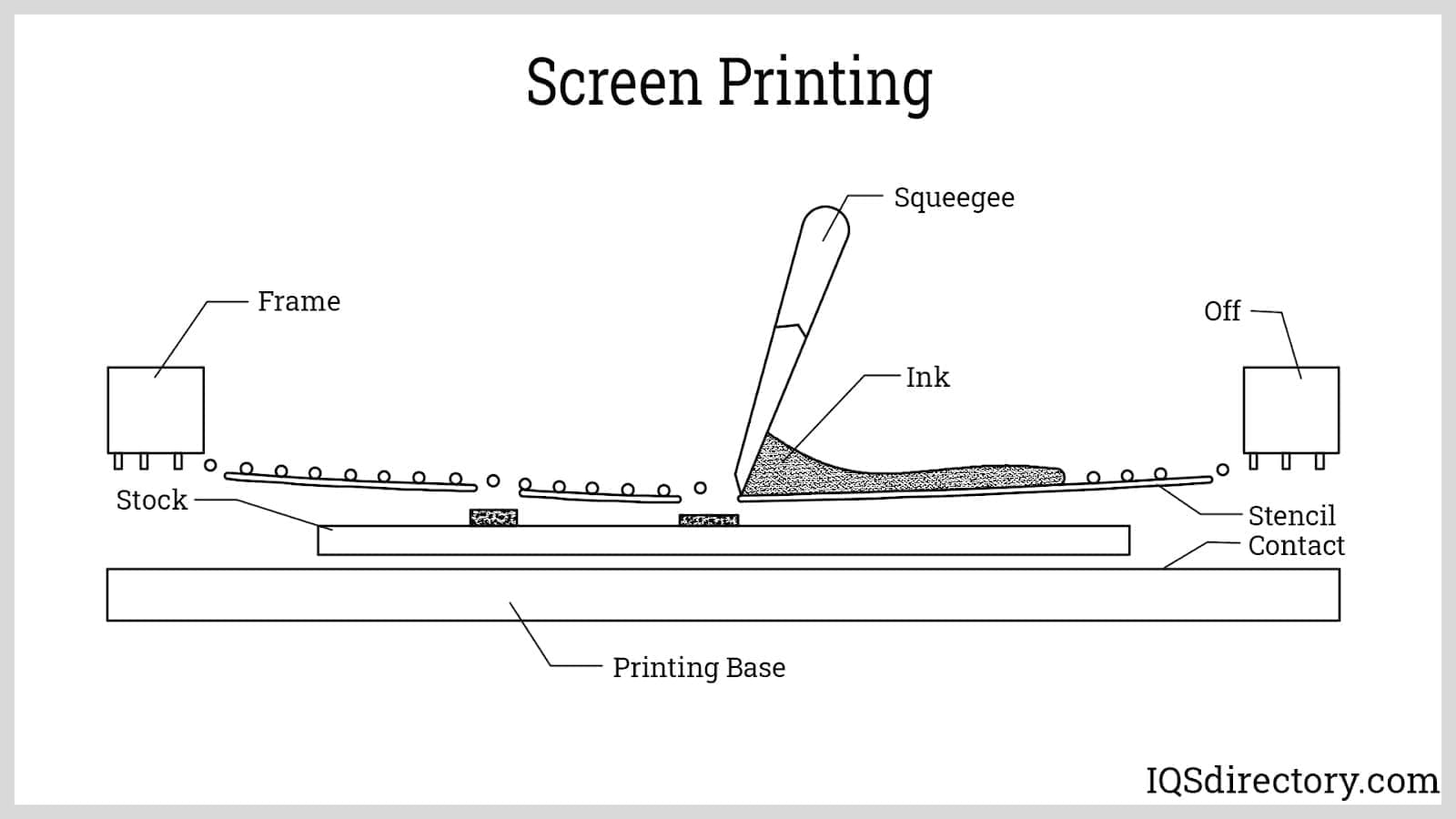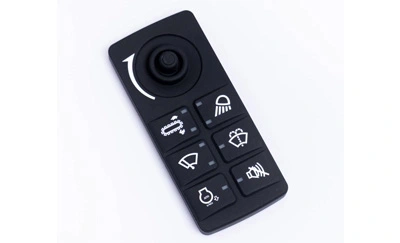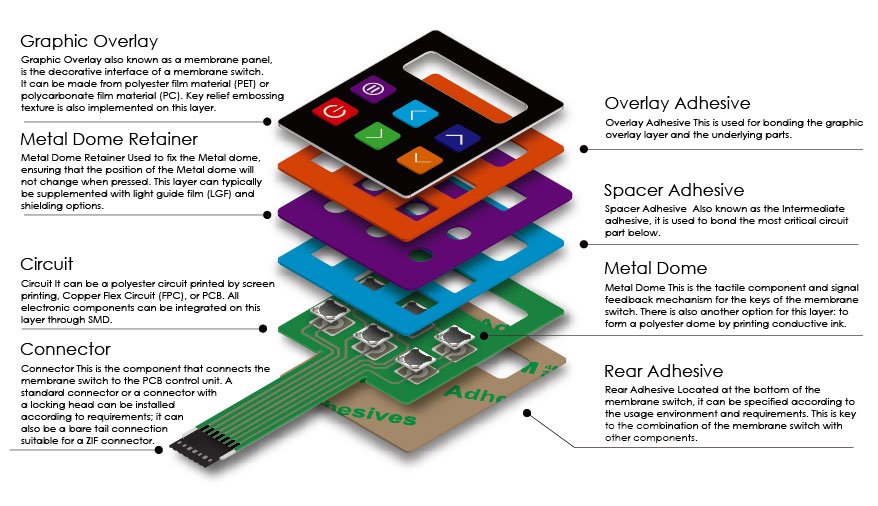The Manufacturing Refine Behind Membrane Switch: What You Required to Know
The manufacturing procedure behind membrane layer switches combines cautious layout, product selection, and top quality control. It begins with recognizing the intricacies of membrane layer switch design and advances with numerous stages, consisting of material options and printing methods. Each phase plays a vital duty in ensuring capability and sturdiness. However, the intricacies of layer building and the rigorous testing criteria might expose understandings that are not instantly obvious. What lies beyond these fundamental aspects?
Recognizing Membrane Layer Switch Design
Membrane layer switches might appear straightforward at initial glimpse, their layout includes detailed factors to consider that assure performance and sturdiness. The layout process starts with a complete understanding of individual needs, including the user interface's intended application and ecological elements. Functional designs is a crucial element, as the layout should facilitate convenience of use while guaranteeing that tactile feedback satisfies customer expectations.Moreover, the layering of components, such as graphic overlays, glue layers, and conductive traces, must be specifically crafted. membrane switch. This layered setup not just influences the button's responsiveness yet likewise affects its longevity. Attention is given to the sealing methods employed to protect versus moisture and dirt, which can jeopardize efficiency. Additionally, layout factors to consider reach aesthetics, where color schemes and visual clarity enhance individual experience. Ultimately, the style of membrane layer switches equilibriums functionality, customer experience, and toughness, guaranteeing that they meet the demands of different applications effectively
Materials Made Use Of in Membrane Change Manufacturing
When selecting materials for membrane switch manufacturing, it is important to contemplate both efficiency and resilience. The main materials consist of polyester and polycarbonate films, which provide flexibility and stamina. These movies are usually coated with adhesive to ensure appropriate bonding to substratums. Conductive inks, generally composed of silver or carbon, are essential for producing electric links within the switch, permitting trusted operation.Additionally, a protective layer, such as a hard coat, is often applied to boost scratch resistance and durability. The selection of backing product, such as acrylic or foam, can considerably affect the button's responsive feeling and overall individual experience. Different ecological elements, consisting of temperature level and humidity, need to direct material choice to assure peak performance in specific applications. Eventually, the best combination of products adds to the membrane layer button's functionality and lifespan, making informed options necessary for manufacturers.
The Printing Refine: Creating Graphics and Text
The printing procedure in membrane layer switch manufacturing plays a significant duty in creating high-quality graphics and message. Numerous visuals style methods are utilized to ensure visual allure and capability, while cautious ink option techniques are important for resilience and efficiency. Comprehending these aspects is fundamental for accomplishing ideal lead to membrane switch layout.
Graphic Design Techniques
Graphic layout techniques play an important role in the printing process of membrane layer buttons, as they specify how graphics and message will eventually show up on the last product. Effective graphic style involves the calculated use shades, formats, and font styles to boost readability and visual appeal. Developers typically utilize vector graphics for scalability, making sure that photos continue to be sharp at various dimensions. Furthermore, focus to contrast and alignment is essential, as it affects user communication and aesthetic high quality. The consolidation of branding aspects, such as logo designs, must be handled with like maintain brand stability. In general, thoughtful visuals style strategies contribute substantially to the functionality and attractiveness of membrane layer switches, affecting customer experience and item performance.
Ink Choice Approaches
Selecting the ideal ink is vital for achieving the desired visual top quality and resilience in membrane button manufacturing. Numerous ink kinds are utilized, including solvent-based, water-based, and UV-curable inks. Each type uses distinctive features, such as attachment, resistance, and versatility to ecological aspects. Solvent-based inks are often preferred for their durability and vivid colors, while water-based inks are more eco friendly however might have restrictions in bond. UV-curable inks give fast healing and robust efficiency. Furthermore, shade matching techniques ensure that the selected inks align with style specs. Ultimately, the choice of ink should think about elements such as application method, substrate compatibility, and end-use requirements to achieve premium outcomes in membrane button graphics and text.
Layer Building And Construction and Setting Up

Product Option Refine
A careful option of products is essential in the production process of membrane layer buttons, as it directly affects functionality and resilience. The primary materials utilized consist of polyester, polycarbonate, and different conductive inks. Polyester is typically favored for its superb resistance to chemicals and abrasion, making it suitable for extreme atmospheres. Polycarbonate, on the various other hand, supplies exceptional quality and influence resistance, which is advantageous for applications calling for presence and effectiveness. Conductive inks, commonly made up of silver or carbon, are important for producing reliable electrical pathways. Furthermore, the selection of glue materials influences the general integrity of the button - membrane switch. Reviewing factors such as ecological direct exposure, tactile comments, and visual requirements overviews suppliers in picking the ideal materials for their certain applications
Layer Bond Strategies
Sticking layers in membrane layer switch building is an essential process that assures performance and long life. Numerous bond techniques are employed to protect ideal bonding in between layers, which commonly include the usage of adhesives, warmth, and pressure. Pressure-sensitive adhesives (PSAs) are frequently used for their simplicity of application and immediate bonding capabilities. In addition, thermal bonding strategies can be applied, where warmth is made use of to activate sticky residential or commercial properties, protecting a strong bond. The option of bond technique mostly relies on the materials entailed and the details application demands of the membrane switch. Appropriate placement and consistent application of adhesives are vital to stop problems, protecting the button runs effectively throughout its desired lifespan.
Quality Assurance Actions
Assuring quality assurance throughout the layer building and construction and setting up of membrane buttons is essential for preserving efficiency and integrity. This procedure generally includes numerous important steps, consisting of extensive assessments at each phase of production. Suppliers utilize innovative screening approaches, such as peel tests and bond evaluations, to validate the honesty of layer bonds. Additionally, aesthetic inspections are conducted to determine any type of flaws in printing or material incongruities. Environmental problems, such as temperature and moisture, are meticulously kept track of to ensure optimal treating and adhesion. Normal calibration of equipment helps maintain specific production standards. By carrying out these quality assurance procedures, makers can greatly reduce the risk of item failing, assuring that the final membrane layer switches satisfy the called for specifications and consumer assumptions.
Evaluating and Quality Assurance Measures

Innovations in Membrane Layer Change Modern Technology
As innovations in innovation remain to advance, membrane layer switches are taking advantage of innovative advancements that improve their capability and user experience. One noteworthy advancement is the combination of capacitive touch modern technology, which enables for even more responsive and user-friendly interface. This change not only improves visual appeals yet additionally minimizes mechanical damage, expanding the life-span of the switches.Additionally, advancements in visuals overlay products have resulted in improved longevity and resistance to environmental factors such as wetness and UV light. These materials currently supply improved quality and brightness, more boosting the aesthetic appeal.Furthermore, the incorporation of wise technology is changing membrane layer switches over right into interactive control board, enabling connection with IoT gadgets. This connection fosters a smooth customer experience, paving the way for applications in various markets, from medical care to customer electronics. Jointly, these advancements position membrane layer changes as essential elements in modern gadget design.
Often Asked Questions
Just how Long Does the Membrane Layer Switch Over Manufacturing Refine Take?
The duration of the membrane button production procedure can vary considerably. Variables such as complexity, products made use of, and manufacturing quantity impact timelines, with regular manufacturing varying from a couple of days to several weeks for conclusion.
What Are the Typical Applications for Membrane Switches?
Membrane layer buttons are typically used in various industries, including vehicle controls, house devices, medical devices, and consumer electronic devices (membrane switch). Their adaptability and longevity make try this web-site them ideal for applications requiring easy to use user interfaces and trustworthy efficiency in varied environments
Can Membrane Layer Switches Be Customized for Certain Requirements?

What Is the Life-span of a Common Membrane Layer Change?
The life-span of a normal membrane switch varies, but typically, it ranges from 1 to 5 million cycles. Elements such as usage, environment, and worldly top quality substantially affect longevity and total performance gradually.

Are Membrane Layer Switches Over Eco Pleasant?
The ecological friendliness of membrane changes varies. Some materials utilized might not be recyclable, while others can be environmentally friendly. The general influence depends upon making methods and products, requiring careful consideration throughout selection and disposal. The production process behind membrane switches over combines cautious style, product selection, and top quality control. It begins with recognizing the ins and outs of membrane switch design and proceeds via different phases, including material choices and printing techniques. When choosing materials for membrane layer switch manufacturing, it is important to consider both performance and longevity. A mindful selection of products is crucial in the manufacturing process of membrane buttons, as it straight affects functionality and sturdiness. The choice of attachment method largely depends on the materials entailed and the specific application demands of the membrane layer button.
Comments on “Exploring membrane switch applications in high-risk environments”